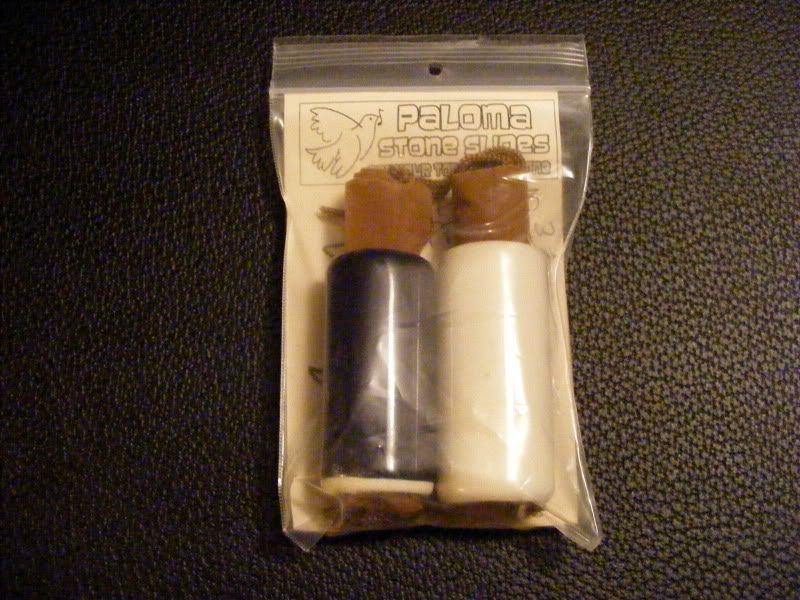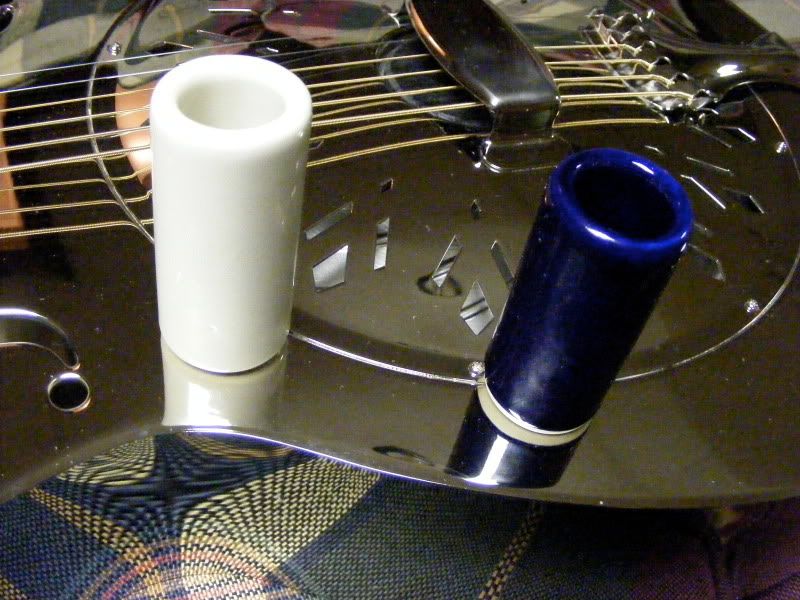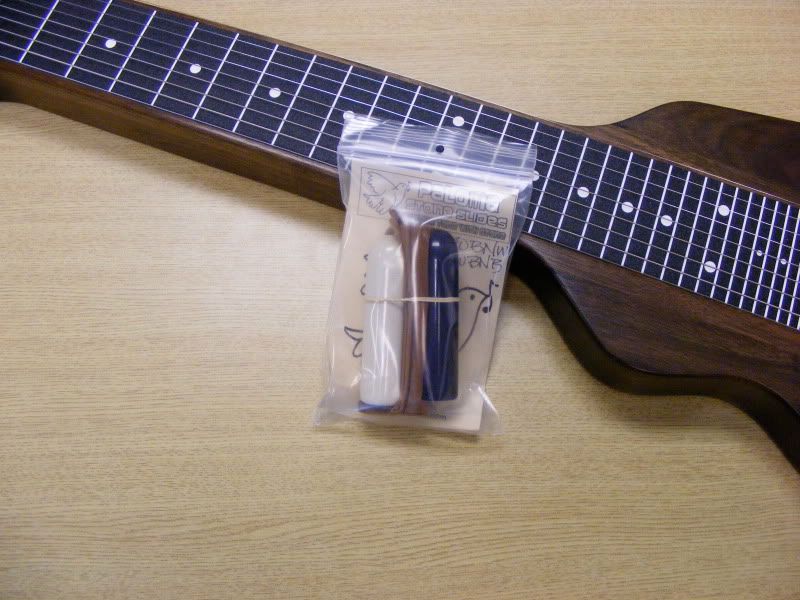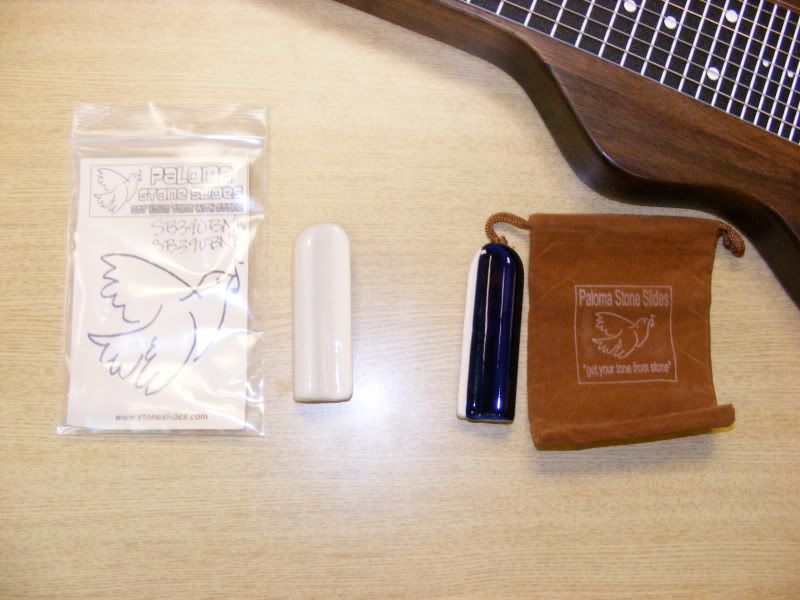I was very interested in these slides when I first saw the announcement about them from Jay Seibert, the maker. Jay's a musician himself, and is active on the Steel Guitar Forum. He and his wife have been making stoneware for ~30 years.
For any who don't know, there are three main categories of pottery: Earthenware, which is a porous material fired at low temperatures and used for cheap stuff. Fragile and non watertight. Porcelain, which is made from fine particle sized clay and other materials and fired at a high temperature that pretty completely vitrifies it into a hard, glassy, translucent substance. If you hold a dish up to light and see light shining through it, it's porcelain. Porcelain's good hard stuff and can ring like a bell, but it also breaks very easily. Then there's stoneware. Stoneware is made from mixtures of materials with a range of particle sizes and fusing temperatures like clay, feldspar, quartz, flint, or a mineral called nepheline syenite. It's fired at very high temperatures, but some of it fuses to glass and some of it doesn't. Think of it as resembling concrete on a microscopic scale, with the gravel and sand held together by the cement matrix. This structure makes it very tough and fracture resistant compared to porcelain. Unglazed or fractured stoneware surfaces have a somewhat rough, gritty texture. It's usually still slightly porous and water absorbent, but glazing takes care of that. Some “high fire†stoneware glazes are as tough, hard and impervious as porcelain, and the glazes Jay uses are in that category. Think of porcelain as the fine china you got for wedding presents, keep in the cabinet on display and get out only for special occasions. Stoneware's the stuff you eat off of all your life. It survives lots of bumps and drops, and doesn't get scratched up with stainless steel utensils sawing against it for decades. Jay uses two glazes, a clear one and a cobalt blue, that are fired to a final temperature of 2460° F. Experience has shown they're reliably hard and tough.
I got two of the Paloma “bottleneck†slides, in the Large size with 22mm inside diameter so I can use them on either my pinky or ring finger (if I were exclusively a ring finger slider I'd have to go to 24mm) in the 69mm length, and two of the SP3BN shaped tone bars with a bullet nose in 90mm length. (I have 8 string as well as 6 string lap steels.) In both styles I got a clear glazed one and a blue glazed one so I could see if there was a tonal difference.
Here are the bottleneck slides:
The clear glazed one is not quite white. It's a pleasant, slightly beige off white, a bone color. The blue is a deep cobalt blue, a familiar color on many stoneware objects. It immediately reminded me of the decorative bands on my stoneware churn in which I used to make muscadine wine. ;-) Whatever Jay uses to hold one end of the bisque fired slides when he dips them in the glaze leaves a ring of unglazed stone at one end. The inside of the tube is glazed. For such large slides, they're very light. I don't have a glass slide of identical dimensions for comparison weighing, but I think the stoneware might be a little lighter. The surface glaze is very smooth in both colors, but not quite as glassy slick as my Diamond Ultimate leaded crystal glass slides. They're like a good bottleneck, with a little fine texture. I don't always want a super slick surface. A rough slide makes all kinds of scratchy noise and isn't good for a lot of playing, but a super slick one won't excite the string when the slide's slid back and forth on the string for vibrato. There's a nice medium where the surface gets a little “bite†on the string for vibrato sustain but doesn't sound noisy. That's a reason why many players like bottlenecks. Well, the Paloma stone slides got that happy medium just right. Stoneware's very rigid structure doesn't absorb sustain by flexing in the slide, either. I was surprised by this, and I may be wrong, but I think the blue glaze is slicker than the clear, which has a little more of the “bite†I'm talking about. But it's very close, and even A/Bing back and forth a lot over a week of playing I don't think I could tell for sure which was which with my eyes closed. Other than this subtle textural difference, I can't hear a tonal difference. Get the one you like the looks of best! These slides are comfortable, sound great, and make for terrific sustain without scratchy noise. I'm not going to deliberately drop them on the floor (as Jay recently did in response to a question, finding that even on concrete they're surprisingly resistant to breakage), but I'm not quite as worried about dropping one as I am about my crystal slides. I can't make up my mind which I like best, the bone-colored clear glaze or the cobalt blue. After a week of playing, I remain deeply ambivalent. The best solution is to get both! I'm not about to quit using my old favorite Ultimate, Craftsman socket, Dunlop #224 brass or Bronze Bomber, but they all have their own special pluses and minuses for different things. These Paloma Stone Slides are going to be new favorites of mine! I love having different options. Slide Acquisition Syndrome is better than GAS, it's cheaper and doesn't take up as much space!
Here are the lap steel tone bars:
The same observations about the glaze texture and sustain apply here. To someone used to using a metal slide, like the Shubb Pearse SP-1 I've been mainly sliding with since playing 8-strings, what's immediately noticeable is how very light these slides are! I had to make an adjustment to applying a little more downforce to the slide, whereas the weight alone of the SP-1 or especially of my big round bullet bar (a Dunlop stainless steel one) will keep them in firm contact with the strings. It's more like the wood handled Gary Swallow and Snakeslide slides I have, made for bluegrass players who do lots of pulloffs and jumping up and down the fretboard. The bullet nose is excellently radiused and smooth. A very nice feature is that the top surface of the bar is left unglazed, helping with an easy, secure grip on the bar. Aids control. The squared off end of the bar isn't as sharp as a metal bar with a sharp edge, which may be important to those who do a lot of pulloffs with the edge. It won't give the string quite as sharp a snap as a metal bar would. Those who suffer from hand fatigue or control problems will appreciate the light weight of the bar. Tonally, I think I don't hear quite as much of the very high harmonics with the stone bars as with metal. It's not a dramatic difference. If you're playing with slide vibrato, sustain goes on as long as you want it to, with no scratchy noise. I think these tone bars are a really nice alternative to the all metal and wood handled shaped bars for lap playing. Paloma also makes round bullet bars, which would be quite different from the metal ones in use due to their lighter weight. I haven't tried one, and really don't play that much with a round bar.
Jay's a musician, and he'll listen to what you want and make some custom alterations like length if you ask him. He extrudes the tubes for the bottleneck slides and the bars, cuts them to length and does final shaping like the beveled ends and bullet noses by hand. I recommend all of these as quality products, that you'll like playing with. Check 'em out here:
http://stoneslides.com/
"A cheerful heart is good medicine."
Ric, thanks for a fantastic review!
Jay uses two glazes, a clear one and a cobalt blue, that are fired to a final temperature of 2460° F. Experience has shown they're reliably hard and tough.
How does it stand up to friction from string windings?
I don't always want a super slick surface. A rough slide makes all kinds of scratchy noise and isn't good for a lot of playing, but a super slick one won't excite the string when the slide's slid back and forth on the string for vibrato. There's a nice medium where the surface gets a little “bite†on the string for vibrato sustain but doesn't sound noisy. That's a reason why many players like bottlenecks.
Great verbal description of the sound we're going for. I take it you get that "bite" from your Craftsman? To me, the sound of the Craftsman vs. the bottleneck is quite different -- smoother, glossier, brighter maybe -- but still perfectly musical -- "bite-y" in a different way. Weird stuff to explain in words.
I love having different options. Slide Acquisition Syndrome is better than GAS, it's cheaper and doesn't take up as much space!
+1 :)
To someone used to using a metal slide, like the Shubb Pearse SP-1 I've been mainly sliding with since playing 8-strings, what's immediately noticeable is how very light these slides are! I had to make an adjustment to applying a little more downforce to the slide, whereas the weight alone of the SP-1 or especially of my big round bullet bar (a Dunlop stainless steel one) will keep them in firm contact with the strings.
This is a factor in bottleneck/Spanish-style sliding as well. Vintage medicine bottles sound great, but they need a little more pressure to make the strings talk. This gets tricky below the fifth fret, at least if you're trying for a setup that allows fretting and sliding in all positions. My Craftsman digs into the strings with its own weight & thus requires more finesse -- less pressure -- down toward the peghead to avoid fretting out. My hand-cut bottleneck is just right in terms of weight/downward force.
Jay's a musician, and he'll listen to what you want and make some custom alterations like length if you ask him. He extrudes the tubes for the bottleneck slides and the bars, cuts them to length and does final shaping like the beveled ends and bullet noses by hand.
This looks like a great deal. Anyone else with hands-on experience with Paloma slides?
"You can't write a chord ugly enough to say what you want to say sometimes, so you have to rely on a giraffe filled with whipped cream." - Frank Zappa
Yep, the Craftsman is very smooth but has a little more bite than my super-slick Diamond Ultimate leaded crystal slide, which is why I swapped out the Diamond for the Craftsman when I played "Dark Was The Night, Cold Was The Ground" in church Good Friday evening. I needed LOTS of sustain. I think the stoneware slides have just a tad more "bite" than the Craftsman. Your point about bottleneck mass is well taken. In general, it's better to have a more massive slide if you use heavier strings, and a lighter slide is more easily controlled when using light strings.
Different slides have different strengths for different tunes and styles of playing. That's why we like to have different ones to choose from. I'll tell you a "secret:" Ian McWee, the owner of Diamond Bottlenecks, has a Craftsman socket he breaks out now and then. I wouldn't be surprised if he ends up sometimes using a Paloma slide, too!
"A cheerful heart is good medicine."
Yep, the Craftsman is very smooth but has a little more bite than my super-slick Diamond Ultimate leaded crystal slide, which is why I swapped out the Diamond for the Craftsman when I played "Dark Was The Night, Cold Was The Ground" in church Good Friday evening. I needed LOTS of sustain.
Slightly off-topic: Do you happen to know what Blind Willie Johnson used for a slide when he recorded the original?
I think the stoneware slides have just a tad more "bite" than the Craftsman.
Sounds like it's somewhere in between a Craftsman and a real bottleneck. At $20 and $4 shipping, this is definitely worth looking into.
"You can't write a chord ugly enough to say what you want to say sometimes, so you have to rely on a giraffe filled with whipped cream." - Frank Zappa
I don't know what slide Blind Willie used. Bottlenecks and brass or copper tubes were popular. His original was actually rather fast-tempo and didn't need a lot of sustain. Like most modern players of DWTNCWTG, I play it a lot more slowly than Mr. Johnson, as Ry Cooder did. I think he started the slowed down, drawn out trend.
"A cheerful heart is good medicine."
I have a Masters degree in ceramics. much of what Ricochet has posted is true. there are some inaccuracies, but for the sake of the slides and thier make up the post re: ceramics isn't far off. bottm line, ceramic makes for a nice slide.
I noticed in the photos the un-glazed bottom area. it is visable in the mirror the slides are sitting on. the clay is white. that could shout 'Porcelin'. but there are high fired clays that color that are not porcelin.
Colbalt is the oxode that gives that gorgeous luminous deep blue color. it first appeared on Chinese ceramics hundreds of years ago. you comonly hear the term 'blue and white' colbalt on porcelin. When the Dutch had a world wide colony going they imported blue and white from China. no one understood how they did it. the Dutch created a lower fire version. blue and white Dutch tile and ceramics are everywhere.
when clay and other ingredients reach temps above 2100 degrees the clay 'vitrifies' and becomes laced with crystaline galls structures. it gives it strengh.
and to our advantage resonance.
low fire clay should not be dismissed and a lesser quality than stoneware. each has their purpose.
whenever the subject of ceramics comes up somehing inside me wakes up.
Hey, I'm no expert on ceramics and am happy to be educated!
"A cheerful heart is good medicine."
you ARE the ex[ert on slides. that is what matters to me. 8)
I don't know about "the slide expert," but I know what I like!
Looked up some academic papers late last night about ceramic microstructures, raw materials, firing, etc. Gets really complicated! :shock: Even such a simple seeming thing as moistening and mixing clay isn't really straightforward at all.
"A cheerful heart is good medicine."
yeah. ceramics can get complicated when you begin to look at chemical structures, properties and weights.
in a way it is akin to the different aspects a slide has by what it is made of. for some folks, a plain ol' metal slide is good enough.then why all the different slides. it gets complex and interesting. like clay.
Yep! :D
"A cheerful heart is good medicine."
They look pretty cool to boot! How much do they cost and where can you order them?
The link was at the very end of my long first post: http://stoneslides.com/
"A cheerful heart is good medicine."





